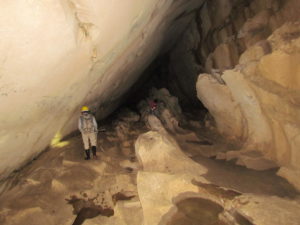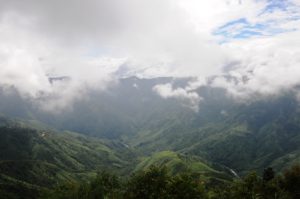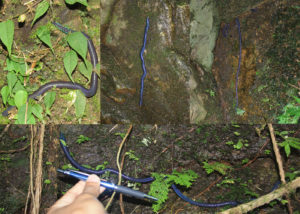By Bhaskar Saikia
On January 21, 2022, Meghalaya attained 50 years of statehood. However, the story of Meghalaya unfolded long before the existence of the world that we know of. The process of the deep internal transformation of the Meghalaya Plateau began about 4 million years ago due to tectonic forces. Located just south of the Himalayas, this plateau is at best considered a  geological miracle.
geological miracle.
The landscape of Meghalaya is unique not because it rose out of a major geologic event but due to the diverse geomorphologic features – both above and underground – that support a rich and interesting biodiversity. The rolling hills and gorgeous valleys, the numerous cascades and the network of caves are a thriving place for diverse species of flora and fauna, as well as home to some of the vibrant people and cultures.
The earliest record about the people of Meghalaya was documented by the Ahoms of nearby Assam in their accounts in Jaintia Buranji. Buranjis are historical chronicles which were commissioned by the Ahom Kingdom for record keeping. However, as the texts of Jaintia Buranji has not been translated, hence, the first detailed record about the people of the State could be traced back to the accounts of Lieutenant Henry Yule of the British Army who had extensively covered the Khasi Hills of the State, which was published in his paper, “Notes on the Kasia Hills, and People”, published by the Journal of the Asiatic Society of Bengal in 1844. A contemporary and friend of Rev. Thomas Jones – the Welch Christian Missionary who had worked among the Khasi people – Lt. Yule travelled to Sohra via Sylhet and documented the landscape and people of the region in nuanced details. Interestingly, Lt. Yule is credited to have coined the term “Living Bridge” after he came across a Living Roots Bridge at Mawsmai area with the help of which he had entered Sohra.
A Living Roots Bridge (LRB), locally called Jingkieng Jri, is a feat of bioengineering and human ingenuity. The locals of the State (particularly of East Khasi Hills and West Jaintia Hills) have been practising the art of making roots bridges across hill streams/rivers out of the flexible secondary roots system of a local rubber tree species (Ficus elastica) since times immemorial. The natives here plant this local rubber species on both sides of a hill-stream/river. Then, when their secondary roots system grows extensively, it is then tied up

with hollow beetle tree trunks which are placed across the stream/river. With the passage of time, these roots cross onto the other side of the stream/river and take roots in the ground. Once their network of roots grows stronger, the locals fill up the gaps with stones and soil. Over years of efforts, local people with the help of nature make these unique structures.
Taking cognisance of this unique practise, the Government of Meghalaya is pitching to the UNESCO World Heritage Committee to include LRBs under its list of natural heritage sites. Recently, the State government had organised a National Convention on LRBs in Shillong on December 21, 2021 to further this objective.
My deep bond with the hills of Meghalaya began in 2009 when I joined the Shillong Regional Office of the Zoological Survey of India (ZSI). A leading government organisation, ZSI is mandated to document the animal diversity of the country and as such, we have pioneering contribution towards the documentation of the fauna of Meghalaya over the last hundred plus years of ZSI’s existence, be it the faunal survey of Siju Cave in 1922 or documenting the faunal pollinators of the rubber plant species with which LRBs are built.
Over the last decade, I have surveyed a large part of the State, including both natural and anthropogenic landscapes. Through these years of explorations, there are two unique instances of biological oddities which the readers might find interesting.
MASS MIGRATION OF BLUE WORMS AT MAWLYNGOT:
 Mawlyngot is a small hamlet located atop a plateau in Mawkynrew Block of East Khasi Hills. The valleys around this hamlet witness a unique mass migratory phenomenon of blue earthworms (Perionyx cf. macintoshi), twice annually – a spring upward migration towards the hills from the valley and an autumn return downward migration towards the water in the valley. Although a couple of instances of sporadic mass migration of earthworms have been observed from the neighbouring Myanmar and Shimla Hills in the distant past, this mass migration of earthworms at Mawlyngot is probably the only continually occurring phenomenon in the world.
Mawlyngot is a small hamlet located atop a plateau in Mawkynrew Block of East Khasi Hills. The valleys around this hamlet witness a unique mass migratory phenomenon of blue earthworms (Perionyx cf. macintoshi), twice annually – a spring upward migration towards the hills from the valley and an autumn return downward migration towards the water in the valley. Although a couple of instances of sporadic mass migration of earthworms have been observed from the neighbouring Myanmar and Shimla Hills in the distant past, this mass migration of earthworms at Mawlyngot is probably the only continually occurring phenomenon in the world.
THRIVING FROG POPULATION INSIDE LYMPUT CAVE:
When we think of animals found inside a cave, our instant thoughts are those of bats. However, I was quite surprised to document a large population of a small trickle dwelling frog species (Ingerana borealis) inside a cave at Nongjri in Pynurlsa Block of East Khasi Hills, called Krem Lymput in January 2020. We recorded these tiny frogs in numerous water holes of the cave floor up to a distance of 2 kms inside from the cave entrance. Perusal of museum records in ZSI, Shillong have confirmed that 2006 onwards, various ZSI teams have encountered this species inside Krem Lymput. However, how this species thrives in a resource scarce cave environ is at best considered an oddity.
When it comes to the caves of Meghalaya, one cannot ignore the fact that the word ‘Meghalaya’ has a global significance in the Earth’s geologic time scale. The history of earth has been divided into eon, era, periods and epochs and each epoch into ages. The latest epoch in the geologic time scale is called Holocene that began about 12,000 years before present, post the last glacial period. In July, 2018, the International Union of Geological Sciences has split the Holocene Epoch into three Ages – the Greenlandian (11,700 – 8,200 years ago), the Northgrippian (8,200 – 4,200 years ago) and the Meghalayan (4,200 years ago to present). About 4,200 years ago, a major two-century long global mega drought have had impacted both climatically and culturally the ancient civilisations around Indus Valley, Yangtze River Valley, Mesopotamia and Eastern Mediterranean, which was determined by studying a speleothem extracted from the Mawmluh cave of the State, which is why this latest geologic age was named the Meghalayan Age.
The landscape of Meghalaya will never stop mesmerising and surprising. The waterfalls of Meghalaya have another unique, yet little known surprise up their sleeves. In his pioneering work, the famous US historian and toponymist, George Rippy Stewart had classified the system of waterfalls in 1975 based on various attributes of a waterfall. He also included a category where he theorised that waterfalls are also named based on folk legends. However, till today, only two waterfalls qualify under this unique criterion – Nohkalikai Falls and Dainthlen Falls. And guess what, where are they found?



